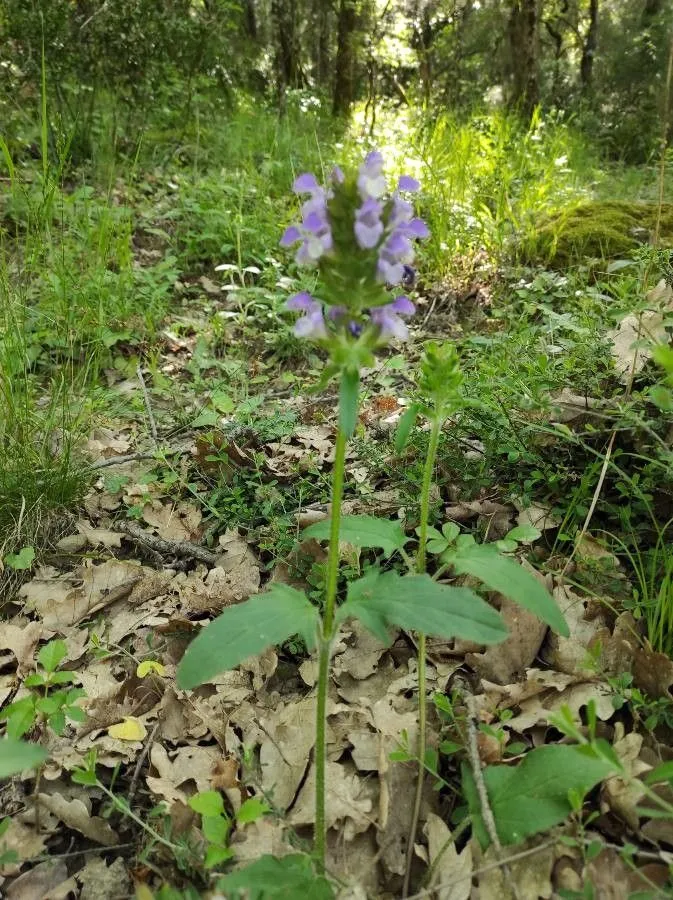
Author: Turra (L.)
Bibliography: Giorn. Italia Sci. Nat. 1:144. 1764
Year: 1764
Status: accepted
Rank: species
Genus: Prunella
Vegetable: False
Observations: Europe to Caucasus
Large selfheal, scientifically known as Prunella grandiflora, is a perennial herbaceous plant belonging to the Lamiaceae family. Described by Turra in 1764 in the Giornale Italiano di Scienze Naturali, this plant is distinguished by its vigorous growth and adaptability, thriving across a broad geographical range from Europe to the Caucasus.
Prunella grandiflora is notable for its attractive, dense clusters of tubular flowers that come in shades of purple, blue, or occasionally white. These vibrant blossoms typically appear during the summer months, complementing the plant’s lush green foliage. The leaves are ovate to lanceolate, with a slightly crenate margin, arranged in opposite pairs along the square stems, a characteristic feature of the mint family to which it belongs.
Ecologically, large selfheal plays an important role in its natural habitat. It serves as a nectar source for a variety of pollinators, including bees and butterflies, thus contributing to the biodiversity and health of its ecosystem. Moreover, the plant is known for its traditional uses in herbal medicine. Historically, various parts of Prunella grandiflora have been used to treat wounds and inflammations, aligning with its common name ‘selfheal’, which speaks to its reputed healing properties.
In garden settings, large selfheal is valued for its low maintenance and high ornamental appeal. It thrives in well-drained soils and can grow in both full sun and partial shade, making it a versatile addition to various garden designs, from borders to wildflower meadows. Its ability to naturalize easily in suitable conditions has made it a favorite among gardeners looking to create pollinator-friendly landscapes without demanding extensive care.
Given its wide range and historical significance, Prunella grandiflora stands out not just for its beauty but also for its ecological and medicinal contributions. Whether encountered in the wild or cultivated in gardens, this member of the Lamiaceae family is a plant that continues to offer beauty, utility, and diversity to its environment.
Nno: storblåkoll
Nob: storblåkoll
En: Large Selfheal, Large-flowered selfheal
Be: Чорнагалоў буйнакветкавы
Ca: Prunel·la grandiflora
Zh: 大花夏枯草
Cs: Černohlávek velkokvětý
Da: Storblomstret Brunelle
Nl: Grote brunel
Et: Suureõiene käbihein
Fi: Isoniittyhumala
Fr: Brunelle a grandes fleurs, Brunelle à grandes fleurs
De: Großblüten-Brunelle, Großblütige Braunelle, Große Braunelle, Große Brunelle
Hu: Nagyvirágú gyíkfű
It: Prunella delle alpi
Lv: Liela brungalvite
Lt: Didžiažiedė juodgalvė
Pl: Głowienka wielkokwiatowa
Ru: Черноголовка крупноцветковая
Sk: Čiernohlávok veľkokvetý
Es: Azafate de la reina, Brunela mayor, Consuelda mayor, Morena gentil, Morenilla española
Sv: Praktbrunört, Isoniittyhumala
Zh-tw: 大花夏枯草
Taken Oct 18, 2022 by Alain Lagrave (cc-by-sa)
Taken Jul 6, 2021 by K. Hanisch (cc-by-sa)
Taken Sep 23, 2021 by Dennis Bergmaier (cc-by-sa)
Taken Aug 3, 2021 by G.J. Postma (cc-by-sa)
Taken Jun 6, 2021 by lairent dugas (cc-by-sa)
© copyright of the Board of Trustees of the Royal Botanic Gardens, Kew.
© copyright of the Board of Trustees of the Royal Botanic Gardens, Kew.
© copyright of the Board of Trustees of the Royal Botanic Gardens, Kew.
Taken May 17, 2021 by Fernandez Cusachs Marc (cc-by-sa)
Taken Apr 16, 2022 by marissa fontaine (cc-by-sa)
Taken Jul 23, 2022 by manuseitz (cc-by-sa)
Taken May 17, 2021 by Fernandez Cusachs Marc (cc-by-sa)
Taken Oct 18, 2022 by Alain Lagrave (cc-by-sa)
Taken Sep 23, 2022 by Werner Rom (cc-by-sa)
Taken Jul 7, 2021 by Par Lio (cc-by-sa)
Taken Aug 22, 2022 by Jiří Voříšek (cc-by-sa)
Taken Jun 9, 2022 by nasrin norozi (cc-by-sa)
Taken May 22, 2021 by Kelly.C (cc-by-sa)
Taken May 13, 2021 by Eduard (cc-by-sa)
Taken Jun 9, 2022 by nasrin norozi (cc-by-sa)
Taken May 13, 2021 by Eduard (cc-by-sa)
Ph maximum: 8.0
Ph minimum: 7.5
Light: 8
Soil nutriments: 3
Family: Myrtaceae Author: (F.Muell.) K.D.Hill & L.A.S.Johnson Bibliography: Telopea 6: 402 (1995) Year: 1995 Status:…
Family: Rubiaceae Author: Pierre ex A.Froehner Bibliography: Notizbl. Bot. Gart. Berlin-Dahlem 1: 237 (1897) Year:…
Family: Sapindaceae Author: Koidz. Bibliography: J. Coll. Sci. Imp. Univ. Tokyo 32(1): 38 (1911) Year:…
Family: Asteraceae Author: A.Gray Bibliography: Pacif. Railr. Rep.: 107 (1857) Year: 1857 Status: accepted Rank:…
Family: Fabaceae Author: Medik. Bibliography: Vorles. Churpfälz. Phys.-Ökon. Ges. 2: 398 (1787) Year: 1787 Status:…
Family: Aspleniaceae Author: (Cav.) Alston Bibliography: Bull. Misc. Inform. Kew 1932: 309 (1932) Year: 1932…